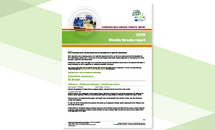Communicable disease threats report, 23-29 September 2012, week 39
The ECDC communicable disease threats report is a weekly bulletin intended for epidemiologists and health professionals in the area of communicable disease prevention and control. Summarising information gathered by ECDC through its epidemic intelligence activities regarding communicable disease threats of concern to the European Union, it also provides updates on the global situation and changes in the epidemiology of communicable diseases with potential to affect Europe, including diseases that are the focus of eradication efforts.
Executive Summary
During September 2012, health authorities were notified of two cases of severe human coronavirus infection caused by a novel virus type. Both patients had travelled, or resided, in Saudi Arabia. ECDC developed a rapid risk assessment and a public version of it was published on 26 September. ECDC’s assessment, based on the limited information currently available, is that the risk of wide spread transmission resulting in severe disease is low.
The previously reported potential autochthonous case of dengue in Agrinio, Greece has now been shown not to have suffered from dengue. Since 1 August 2011, 169 out of 429 reported cases of S. Stanley have been confirmed as having indistinguishable XbaI-PFGE patterns. The number of new cases per month has been steadily growing since April.
The ECDC communicable disease threats report is a weekly bulletin intended for epidemiologists and health professionals in the area of communicable disease prevention and control.
Download





